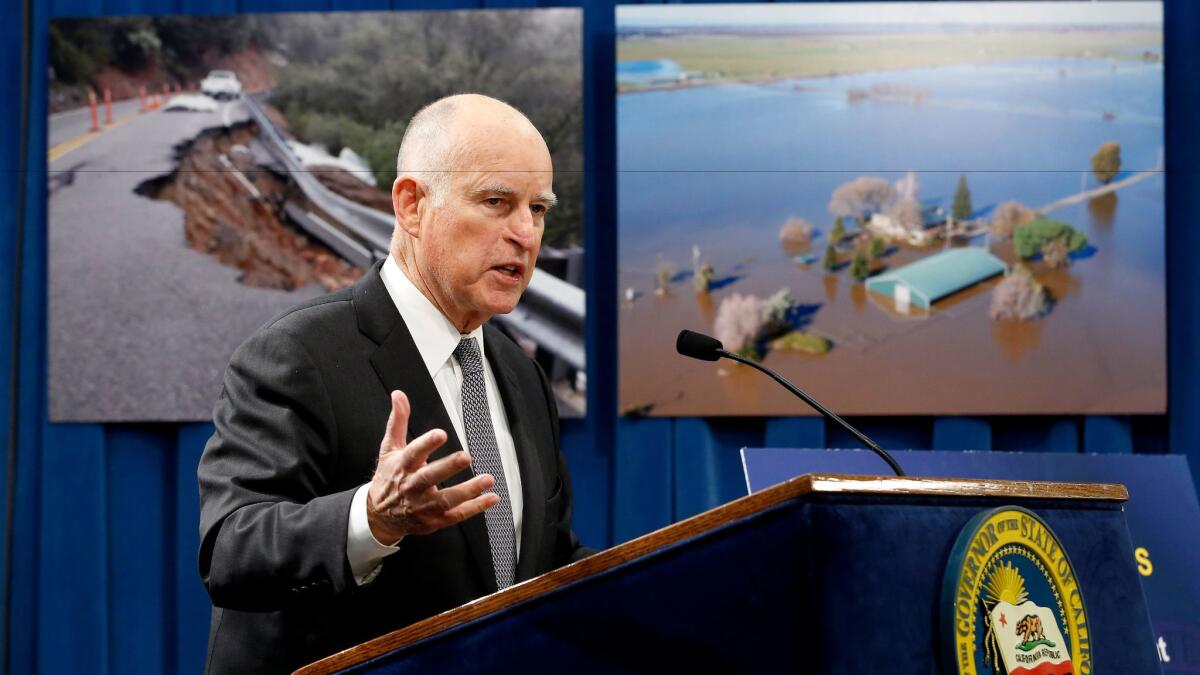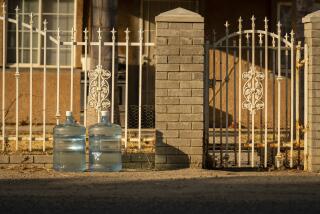A winter’s worth of storms prompts Gov. Jerry Brown to ask for $437 million in flood and emergency relief

Sacramento — Warning that it will only amount to a small down payment on a large and costly problem, Gov. Jerry Brown unveiled a $437-million request Friday to speed up flood control efforts in Northern California and boost the readiness of the state’s emergency operations.
“These liabilities are a serious cloud, and we have to take them seriously,” said Brown in a news conference in Sacramento.
The proposal, quickly stitched together by the governor’s administration as a response to a winter of pounding storms, offers up a speedier time frame for efforts that have been underway for some time. State officials had expected to complete most of the flood control work over five years, but Brown’s new proposal would do so in just two years.
“What’s required is to take some immediate action,” the governor said.
Even so, the new effort does not address what Brown’s budget director said Friday is at least a $1-billion price tag for damage in the state caused by floodwaters and emergency evacuations. The crisis at the Oroville Dam — and the damage to the facility’s main and backup spillways — offered a glimpse at California’s hidden public works problems. Usage of the backup spillway caused extensive erosion, which later threatened to take a huge bite out of the side of the reservoir and forced the evacuation of more than 100,000 people.
The crisis eased after dam managers were able to lower the lake’s level. But interviews and records suggest that the near-catastrophe grew out of fundamental problems with the original design of the emergency spillway that were never corrected despite questions about the design’s adequacy.
These liabilities are a serious cloud, and we have to take them seriously.
— Gov. Jerry Brown, in promoting a $437-million infrastructure package
Brown said Friday that he was satisfied with the response by state water officials to the Oroville emergency. And while he said additional efforts will be undertaken to better understand what happened, he cautioned against demanding guarantees when dealing with the impacts of severe weather.
“There will be problems; we will not live a trouble-free existence,” Brown said.
The government misjudged the strength of Oroville’s emergency spillway »
The governor’s proposal seeks approval from the Legislature to accelerate $387 million of borrowing authorized by Proposition 1, a $7.1-billion water bond approved by voters in 2014. While the specific projects won’t be identified until later, the effort would focus on enhanced protection in areas with significant flood risk. That includes sites across the Central Valley and the Sacramento-San Joaquin River Delta.
An additional $50 million in the plan would be spent on emergency preparedness programs, from levee inspections to stocking up on materials needed to fight rising floodwaters. The money would come, however, at the expense of further delays in maintenance on other levee locations.
Those kinds of deferrals were at the heart of what may have been Brown’s most impassioned remarks at his state Capitol news conference — with several reminders that the state has accumulated a towering stack of unfunded infrastructure repairs and upgrades.
In all, he put the tally at $187 billion when also considering the work needed on California’s sprawling network of roads and highways.
“Look, if we’re going to have a civilization, we’re going to pay for it,” he said. “These are big projects. And anything big today challenges the Lilliputian mind that is still operative in too many political circles.”
The proposal also assumes additional help from the federal government. Brown sent letters on Friday to the secretaries of Defense and Homeland Security, asking for additional federal dam inspections and revised reservoir operating rules that reflect the latest scientific data about storms and rainfall potential. Those letters both had a note at the bottom, scrawled in the governor’s handwriting: “This is both an urgent need and a real opportunity!”
Brown also sent a request to President Trump for faster-than-usual environmental review of repairs to the Oroville Dam spillways and nine transportation projects. The plea met with criticism from some environmentalists who pointed out that the Oroville concerns were first pointed out as far back as 2005.
“Over and over again, people all along the way, who had the ability to put a halt to a very dangerous situation, didn’t do anything,” said Kathryn Phillips, director of Sierra Club California. She said the public review process is “part of the reason you have this ability to know what’s going on.”
Brown’s attempt to portray the package of flood proposals as driven by pragmatism could also be seen in his defense of its reliance on help from the Trump administration. While Brown has occasionally taken Trump to task in the early days and weeks of his presidency, the veteran governor admonished on Friday those who might view the requests as anathema to being a good Democrat.
“We are inextricably linked to the federal government,” Brown said. “We have to, I think, walk a very thoughtful line here, seeking help that we need but also calling attention to those things we object to.”
Times staff writers Chris Megerian and Bettina Boxall contributed to this report.
Follow @johnmyers on Twitter, sign up for our daily Essential Politics newsletter and listen to the weekly California Politics Podcast
ALSO:
How Oroville hopes to turn the dam crisis into a tourism opportunity
Shasta Dam makes history as water flows from the spillway for the first time in 20 years
More to Read
Get the L.A. Times Politics newsletter
Deeply reported insights into legislation, politics and policy from Sacramento, Washington and beyond. In your inbox three times per week.
You may occasionally receive promotional content from the Los Angeles Times.











